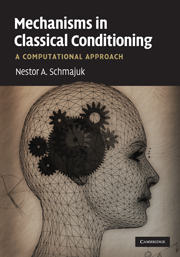Book contents
- Frontmatter
- Contents
- Preface
- Acknowledgments
- Abbreviations
- Part I Introduction
- Part II Attentional and associative mechanisms
- Part III Configural mechanisms
- 11 A configural model of conditioning
- 12 Occasion setting
- 13 The neurobiology of occasion setting
- Part IV Attentional, associative, configural and timing mechanisms
- Part V Conclusion: mechanisms of classical conditioning
- References
- Author Index
- Subject Index
11 - A configural model of conditioning
from Part III - Configural mechanisms
Published online by Cambridge University Press: 23 May 2010
- Frontmatter
- Contents
- Preface
- Acknowledgments
- Abbreviations
- Part I Introduction
- Part II Attentional and associative mechanisms
- Part III Configural mechanisms
- 11 A configural model of conditioning
- 12 Occasion setting
- 13 The neurobiology of occasion setting
- Part IV Attentional, associative, configural and timing mechanisms
- Part V Conclusion: mechanisms of classical conditioning
- References
- Author Index
- Subject Index
Summary
This chapter introduces a configural neural network model of classical conditioning offered by Schmajuk and DiCarlo (1992) and modified by Schmajuk, Lamoureux and Holland (1998) in order to account for data on occasion setting. In Chapter 12, we evaluate the model by applying it to the experimental results in which occasion setting is observed.
Skinner (1938) suggested that a discriminative stimulus in an operant conditioning paradigm does not elicit a response, but simply sets the occasion for the response to occur. More recently, many investigators (e.g. Bouton & Nelson, 1994; Holland, 1983, 1992; Rescorla, 1985, 1992) have claimed that Pavlovian conditioning procedures can also endow stimuli with occasion setting functions, as well as simple associative functions. Whereas a simple conditioned stimulus (CS) may elicit conditioned responses (CRs) because it signals the occurrence of an unconditioned stimulus (US), an “occasion setter” (Holland, 1983, 1992) or “facilitator” (Rescorla, 1985) may instead modulate responding generated by another CS by indicating the relation between that CS and the US. Rather than signaling the delivery of the US, an occasion setter indicates whether another cue is to be reinforced (or not reinforced), setting the occasion for its reinforcement (or nonreinforcement). Extensive evidence seems to support this distinction between simple conditioning and occasion setting, and suggests that these two functions are acquired under different circumstances, manifest many different behavioral properties and often act quite independently of each other (see Holland, 1992; Swartzentruber, 1995, for comprehensive reviews.)
- Type
- Chapter
- Information
- Mechanisms in Classical ConditioningA Computational Approach, pp. 245 - 256Publisher: Cambridge University PressPrint publication year: 2010



